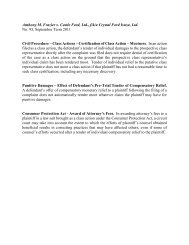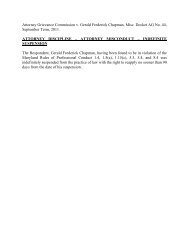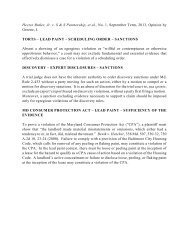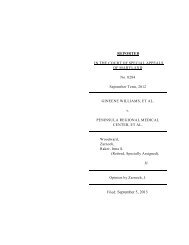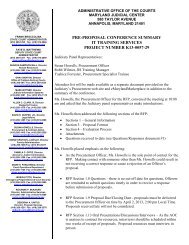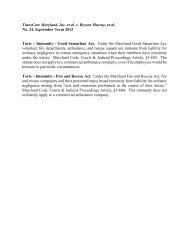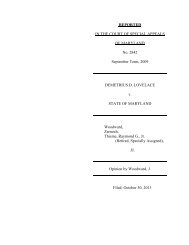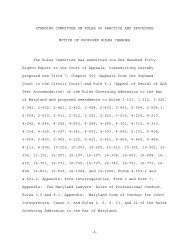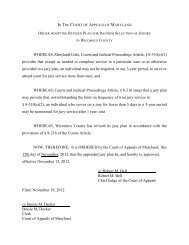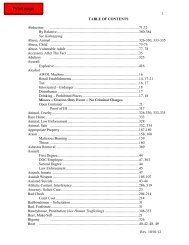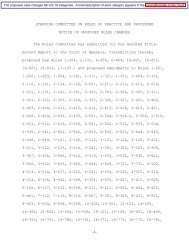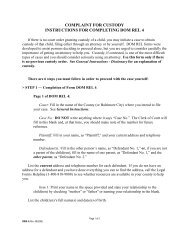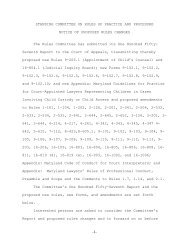Liddy v. Lamone - Maryland state court system
Liddy v. Lamone - Maryland state court system
Liddy v. Lamone - Maryland state court system
You also want an ePaper? Increase the reach of your titles
YUMPU automatically turns print PDFs into web optimized ePapers that Google loves.
Nikos Stanford <strong>Liddy</strong> v. Linda H. <strong>Lamone</strong>, et al., No. 71, September Term 2006.<br />
Opinion by Bell, C.J.<br />
ELECTIONS - CIVIL PROCEDURE - AFFIRMATIVE DEFENSES - LACHES<br />
An action challenging the constitutional qualifications of a candidate for the office of the<br />
Attorney General filed more than three months after a similar action, almost 2 months<br />
after this Court’s Order in that case and just 18 days prior to the general election, is barred<br />
by the equitable doctrine of laches.
IN THE COURT OF APPEALS OF<br />
MARYLAND<br />
No. 71<br />
September Term, 2006<br />
NIKOS STANFORD LIDDY<br />
v.<br />
LINDA H. LAMONE, ET AL.<br />
Bell, C. J.<br />
Raker<br />
*Wilner<br />
Cathell<br />
Harrell<br />
Battaglia<br />
Greene,<br />
JJ.<br />
Opinion by Bell, C. J.<br />
Filed: March 29, 2007<br />
*Wilner, J., now retired, participated in the<br />
hearing and conference of this case while an<br />
active member of this Court; after being<br />
recalled pursuant to the Constitution, Article<br />
IV, Section 3A, he also participated in the<br />
decision and adoption of this opinion.
This is the second of two cases involving the eligibility requirements of a candidate<br />
for the office of the Attorney General of <strong>Maryland</strong>. In Abrams v. <strong>Lamone</strong>, __ Md. __, __<br />
A.2d __ (2007), this Court considered a petition by Stephen A. Abrams (“Abrams”) 1<br />
challenging the eligibility of Thomas E. Perez (“Perez”) to hold the office of the Attorney<br />
General. In Abrams, a case of first impression for this Court, this Court was required to<br />
interpret Article V, Section 4 of the <strong>Maryland</strong> Constitution, which provides:<br />
“No person shall be eligible to the office of Attorney-General, who is not a<br />
citizen of this State, and a qualified voter therein, and has not resided and<br />
practiced Law in this State for at least ten years.” (Emphasis added).<br />
Concluding that Perez had not met the eligibility requirements, i.e., he had not been a<br />
member of the <strong>Maryland</strong> Bar for the requisite period, we reversed the judgment of the Circuit<br />
Court for Anne Arundel County, __ Md. at __, __ A.2d at __, which had ruled that Perez met<br />
the necessary qualifications to run in the 2006 Gubernatorial Primary Election. 2<br />
1 Abrams filed his action in the Circuit Court for Anne Arundel County on July 13,<br />
2006. In it, he sought an order declaring that Perez did not have the qualifications<br />
required for the office of the Attorney General and injunctions requiring Perez to<br />
withdraw his certificate of candidacy and prohibiting Linda H. <strong>Lamone</strong>, in her official<br />
capacity as the State Administrator of Elections, and the State Board of Elections from<br />
placing Perez’s name on the ballot as a candidate for the office of the Attorney General.<br />
2 This Court filed a Per Curiam Order on August 25, 2006, holding that Perez was<br />
not qualified to run for the office of the Attorney General and that his name was to be<br />
removed from the primary election ballot. The appellees sought modification of the<br />
portion of the Order that required Perez’s name to be removed from the ballot because<br />
they claimed, with only 18 days remaining before the primary election, that it was<br />
impossible for them to reprogram voting machines or reorder paper ballots for absentee<br />
and provisional voters in order to prepare an entirely new ballot. This Court granted the<br />
appellees’ motion and issued a modified Per Curiam Order on August 29, 2006. That<br />
Order directed the local boards of elections to post notices conspicuously in each polling
The instant challenge was brought by Nikos Stanford <strong>Liddy</strong> (“<strong>Liddy</strong>”), the appellant,<br />
against Douglas F. Gansler (“Gansler”), one of the appellees, the victor in the September<br />
12, 2006 primary election, thus the Democratic Party’s nominee for the office of the<br />
Attorney General. In addition to Gansler, the appellant also named Linda H. <strong>Lamone</strong><br />
(“<strong>Lamone</strong>”), the State Administrator of Elections, and the State Board of Elections (“the<br />
State Board”), collectively, the appellees, as defendants. It was filed on October 20, 2006,<br />
more than three months after the Abrams suit, almost two months after this Court’s Order in<br />
that case, and just 18 days prior to the November 7, 2006 general election. In the complaint,<br />
he asserted that Gansler, like Perez, was ineligible to run for the office of the Attorney<br />
General, arguing that Gansler has not “practiced Law in this State for at least ten years.”<br />
There is, however, a threshold issue which must be addressed, whether the appellant<br />
waited too long to bring this action and, thus, is barred, by the equitable doctrine of laches,<br />
from bringing it now. 3 We shall hold that this action is barred by laches.<br />
location to inform voters that Perez was not a candidate for the office of the Attorney<br />
General and that any votes cast for him would not be counted.<br />
A.<br />
3 The appellees, <strong>Lamone</strong> and the State Board, claimed, in addition, that the<br />
appellant’s action is barred by § 12-202 of the Election Law Article, specifically § 12-<br />
202(b)(2), see infra note 7, at 4, the applicable statute of limitations. They argued that the<br />
action needed to have been brought within three days of the certification of the primary<br />
election results by the State Board. Because that occurred on September 26, 2006, the<br />
appellant, they submit, should have brought his action by September 29, 2006 . We,<br />
however, need not address this issue, as we are disposing of the appellant’s claim on the<br />
equitable theory of laches.<br />
2
As <strong>state</strong>d earlier, in order for one to run for the office of the Attorney General, one<br />
must be qualified to do so. Article V, § 4 of the <strong>Maryland</strong> Constitution prescribes those<br />
qualifications. In addition, under the current Election Law Article, see <strong>Maryland</strong> Code<br />
(2003, 2006 Cum. Supp.), §§ 1-101, et seq., a candidate wishing to hold the office of the<br />
Attorney General must register his or her candidacy by filing, with the State Board, pursuant<br />
to § 5-301(a), 4 a certificate of candidacy, under oath. 5 On June 28, 2006, Gansler filed his<br />
certificate of candidacy, in which he certified that he is “a registered voter and a citizen of<br />
<strong>Maryland</strong> and meet[s] all other requirements for the...office [of the Attorney General].” The<br />
State Board accepted Gansler’s certificate and, pursuant to § 5-601(1) 6 of the Election Law<br />
4<br />
<strong>Maryland</strong> Code (2003, 2006 Cum. Supp.) § 5-301(a) of the Election Law Article<br />
provides:<br />
“In general<br />
“(a) An individual may become a candidate for a public or party office only<br />
if:<br />
“(1) the individual files a certificate of candidacy in<br />
accordance with this subtitle; and<br />
“(2) the individual does not file a certificate of withdrawal<br />
under Subtitle 5 of this title.” (Emphasis added).<br />
5<br />
See <strong>Maryland</strong> Code (2003, 2006 Cum. Supp.) § 5-302(a) of the Election Law<br />
Article, which provides:<br />
“On form<br />
“(a) A certificate of candidacy shall be filed under oath on the prescribed<br />
form.”<br />
6<strong>Maryland</strong> Code (2003, 2006 Cum. Supp.) § 5-601(a) of the Election Law Article<br />
provides:<br />
“The name of a candidate shall remain on the ballot and be submitted to the<br />
voters at a primary election if:<br />
“(1) the candidate has filed a certificate of candidacy in<br />
accordance with the requirements of § 5-301 of this title and<br />
3
Article, placed his name on the ballot for the 2006 Gubernatorial Primary Election.<br />
The Election Law Article also provides that any registered voter may seek judicial<br />
relief if he or she alleges that an “act or omission relating to an election, whether or not the<br />
election has been held, is inconsistent with th[e Election Law A]rticle or other law applicable<br />
to the elections process and may change or has changed the outcome of the election,”<br />
provided that the action is filed “within the earlier of 10 days after the act or omission or<br />
the date the act or omission became known to the petitioner or 7 days after the election<br />
results are certified, unless the election was a gubernatorial primary or special primary<br />
election, in which case 3 days after the election results are certified.” 7 As <strong>state</strong>d earlier,<br />
has satisfied any other requirements of this article relating to<br />
the office which the individual is a candidate, provided the<br />
candidate<br />
“(i) has not withdrawn the candidacy in<br />
accordance with Subtitle 5 of this title;<br />
“(ii) has not died or become disqualified, and<br />
that fact is known to the applicable board by the<br />
deadline prescribed in § 5-504(b) of this title;<br />
“(iii) does not seek nomination by petition<br />
pursuant to the provisions of § 5-703 of this<br />
title; or<br />
“(iv) is not a write-in candidate.”<br />
7 See <strong>Maryland</strong> Code (2003, 2006 Cum. Supp.) § 12-202 of the Election Law<br />
Article, which provides:<br />
Ҥ 12-202. Judicial challenges<br />
“(a) In general. If no other timely and adequate remedy is provided by this<br />
article, a registered voter may seek judicial relief from any act or omission<br />
relating to an election, whether or not the election has been held, on the<br />
grounds that the act or omission:<br />
“(1) is inconsistent with this article or other law applicable to<br />
4
<strong>Liddy</strong> brought a challenge to Gansler’s qualifications. He did so on October 20, 2006, when<br />
he sought declaratory and injunctive relief against Gansler, <strong>Lamone</strong>, and the State Board<br />
because, he claimed, Gansler’s legal experience did not satisfy Article V, § 4's requirement<br />
that a candidate for that office “practice[] Law in this State for at least ten years.”<br />
Gansler filed a Motion to Dismiss Or, In The Alternative, for Summary Judgment,<br />
contending that he met all eligibility requirements for the office. Moving to dismiss and<br />
expedite scheduling, the other appellees contended that <strong>Liddy</strong>’s action was barred by<br />
limitations and by laches. In support, they alleged that their sole interest in the action was<br />
to ensure an orderly administration of the election process, the deadlines of which would be<br />
jeopardized if the action were not adjudicated expeditiously. 8<br />
the elections process; and<br />
“(2) may change or has changed the outcome of the election.<br />
“Place and time of filing<br />
“(b) A registered voter may seek judicial relief under this section in the<br />
appropriate circuit <strong>court</strong> within the earlier of:<br />
“(1) 10 days after the act or omission or the date the act or<br />
omission became known to the petitioner; or<br />
“(2) 7 days after the election results are certified, unless the<br />
election was a gubernatorial primary or special primary<br />
election, in which case 3 days after the election results are<br />
certified.” (Emphasis added).<br />
8 A number of stipulations were placed on the record, in support of the appellees’<br />
position: that Gansler filed his certification for candidacy on June 28, 2006; the 2006<br />
Gubernatorial Primary Election was held on September 12, 2006, and the primary election<br />
results were certified on September 26, 2006; plaintiff’s Complaint was filed on October<br />
20, 2006; on October 25, 2006, 138,043 applications for absentee ballots had been<br />
received by the State Board, of which 7,074 were from service members overseas; the<br />
deadline for the filing of such applications was October 31, 2006; 14,277 absentee ballots<br />
had already been cast and received by the State Board; 19,000 electronic voting machines<br />
5
Following a hearing at which it heard extensive testimony pertaining to the merits of<br />
Gansler’s constitutional eligibility for the office of the Attorney General, the Circuit Court<br />
for Anne Arundel County denied the dispositive motions filed by the appellees and Gansler. 9<br />
Although the Circuit Court addressed, in addition to laches, the issues of the applicable<br />
statute of limitations and the merits of the case, we will confine our discussion to the<br />
equitable doctrine of laches. 10<br />
had been deployed throughout the State, and 13 of the 24 election jurisdictions had<br />
completed the required testing of these units; and an upward of 1.1 million paper ballots,<br />
of more than 200 different styles, had been ordered and were in the process of being<br />
delivered to the more than 3 million registered <strong>Maryland</strong> voters.<br />
9 Pertaining to the merits of the case, <strong>Liddy</strong> testified that he first became aware of<br />
Gansler’s lack of qualifications for Attorney General during the week of October 16,<br />
2006 when he was conducting some research on the Internet. There he claims to have<br />
found information on Gansler’s limited practice of law in <strong>Maryland</strong>. He, in fact, testified<br />
that, apart from Gansler’s service for the past eight years as State’s Attorney for<br />
Montgomery County, the sites he consulted referred only to Gansler’s practice in<br />
Washington, D.C. and not in <strong>Maryland</strong>. Based on this information, <strong>Liddy</strong> inferred that<br />
Gansler did not meet the constitutional ten-year practice of law requirement and decided<br />
to bring suit challenging Gansler’s continued candidacy for the office of the Attorney<br />
General.<br />
Gansler, on the other hand, testified to having continuously practiced law in the<br />
State since his admission to the <strong>Maryland</strong> Bar in 1989. He cited his judicial clerkship<br />
from 1989-90 and numerous pro bono matters he handled in the State while practicing in<br />
the District of Columbia, before becoming the State’s Attorney for Montgomery County.<br />
10 On the issue of the applicable statute of limitations, the Circuit Court <strong>state</strong>d that<br />
Ҥ12-202(b)(2) does not yet apply because the general election has not yet taken place,<br />
and consequently, the election results have not yet been certified.” The <strong>court</strong> continued,<br />
stating that “[b]ecause the general election has not yet been held, the ‘earlier of’ the two<br />
deadlines set forth in §12-202(b) is §12-202(b)(1), ten days of it being known to the<br />
Plaintiff that an allegedly ineligible candidate will be running in the general election.” See<br />
<strong>Maryland</strong> Code (2003, 2006 Cum. Supp.) § 12-202 of the Election Law Article, supra<br />
note 7, at 4. The <strong>court</strong> ultimately held that <strong>Liddy</strong>’s claim was not barred by any<br />
6
On the issue of laches, the appellees argued that the appellant’s claim was “an<br />
eleventh hour lawsuit that threaten[ed] to disrupt the entire elections machinery, to sew doubt<br />
in the minds of voters, to create voter confusion and uncertainty, and generally to defeat<br />
voters’ choices.” The appellees maintained “voters ought to be able to make their choice<br />
intelligently and based on the ballots that have been created and in accordance with the<br />
election law.” The appellees’ paramount concern was the prejudice this action would have<br />
on the electorate and its choice of Attorney General candidates. In addition, they outlined<br />
the various procedures which had already taken place, and which were in the process of<br />
taking place, and insisted that the appellant’s claim was simply brought too close to the<br />
general election to allow any changes or alterations to be made. The process was well<br />
underway, and to grant the appellant the relief he requested, i.e. the removal of Gansler’s<br />
name from the general election ballot, at such a late stage “would lead to an unmanageable<br />
disruption of the general election and disenfranchise thousands of voters.” Conversely, the<br />
appellant argued that the constitutional issue, the interpretation of Article V, § 4, outweighed<br />
any merit found in the laches defense.<br />
In rejecting the appellees’ arguments, the Circuit Court, citing Ross v. State Board of<br />
applicable statute of limitations because it had “no reason to disbelieve his testimony that<br />
he recently came to the conclusion on October 16, 2006, while accessing the internet, that<br />
Mr. Gansler had only practiced law in this State for eight years.”<br />
Addressing the merits of the case, the Circuit Court found, as a factual matter, that<br />
“Mr. Gansler does possess the requisite ten (10) years of practice in <strong>Maryland</strong> making<br />
him eligible to run for the Office of the Attorney General.”<br />
7
Elections, 387 Md. 649, 671, 876 A.2d 692, 705 (2005), held that application of laches was<br />
inappropriate in a situation such as the case sub judice. It determined that <strong>Liddy</strong> was “not<br />
responsible for any inexcusable delay in the processing of his complaint [and found] it<br />
inappropriate to allow the general election to go forward without examining whether a<br />
candidate who may become this State’s next Attorney General is constitutionally eligible to<br />
hold that office.” The <strong>court</strong> further noted, on the issue of prejudice, that “Mr. Gansler<br />
cannot be prejudiced because if, in fact, he does not meet the eligibility requirements, he<br />
ought not to be on the ballot. The S[tate] B[oard of] E[lections] is not prejudiced because<br />
it is undisputed that at this late date, there is nothing that can be done to alter the makeup of<br />
the ballot for this election.” On the other hand, the <strong>court</strong> noted that “Plaintiff [<strong>Liddy</strong>] and<br />
similarly situated voters would be prejudiced if an ineligible candidate were to remain on the<br />
ballot because of a delay in finding out about the lack of eligibility.”<br />
Although the appellant prevailed on the dispositive motions, the Circuit Court<br />
ultimately ruled in favor of Gansler and his continued candidacy for the office of the<br />
Attorney General. The appellant, pursuant to § 12-203(a) 11 of the Election Law Article, in<br />
11<strong>Maryland</strong> Code (2003, 2006 Cum. Supp.) § 12-203(a) of the Election Law Article<br />
provides:<br />
“(a) In general. A proceeding under this subtitle shall be conducted in accordance<br />
with the <strong>Maryland</strong> Rules, except that:<br />
“(1) the proceeding shall be heard and decided without a jury and as<br />
expeditiously as the circumstances require;<br />
“(2) on the request of a party or sua sponte, the chief administrative judge<br />
of the circuit <strong>court</strong> may assign the case to a three-judge panel of circuit<br />
<strong>court</strong> judges; and<br />
8
esponse, noted an appeal to this Court and to the Court of Special Appeals. In addition, he<br />
filed, in this Court, a Petition for Writ of Certiorari, which this Court granted. <strong>Liddy</strong> v.<br />
<strong>Lamone</strong>, 395 Md. 420, 910 A.2d 1061 (2006). The appellees and Gansler subsequently filed<br />
a Joint Cross-Petition for Writ of Certiorari. Oral argument was heard on November 2, 2006,<br />
and, on that same day, the Court issued its Order vacating the judgment of the Circuit Court<br />
and remanding the case to that <strong>court</strong> with directions to dismiss it on the ground of laches.<br />
We now set forth the reasons for that Order.<br />
B.<br />
Laches is one of the affirmative defenses recognized and expressly listed in Md. Rule<br />
2-323. 12 Generally, it must be pled, but it can be invoked by a <strong>court</strong> on its own initiative.<br />
“(3) an appeal shall be taken directly to the Court of Appeals within 5 days<br />
of the date of the decision of the circuit <strong>court</strong>.” (Emphasis added).<br />
12 <strong>Maryland</strong> Rule 2-323 provides, in pertinent part:<br />
“ANSWER<br />
* * *<br />
“(g) Affirmative Defenses. Whether proceeding under section (c) or section (d) of<br />
this Rule, a party shall set forth by separate defenses: (1) accord and satisfaction,<br />
(2) merger of a claim by arbitration into an award, (3) assumption of risk, (4)<br />
collateral estoppel as a defense to a claim, (5) contributory negligence, (6) duress,<br />
(7) estoppel, (8) fraud, (9) illegality, (10) laches, (11) payment, (12) release, (13)<br />
res judicata, (14) statute of frauds, (15) statute of limitations, (16) ultra vires, (17)<br />
usury, (18) waiver, (19) privilege, and (20) total or partial charitable immunity.<br />
“In addition, a party may include by separate defense any other matter constituting<br />
an avoidance or affirmative defense on legal or equitable grounds. When a party<br />
has mistakenly designated a defense as a counterclaim or a counterclaim as a<br />
defense, the <strong>court</strong> shall treat the pleading as if there had been a proper designation,<br />
if justice so requires.”<br />
9
See, e.g., Ipes v. Board of Fire Comm’rs of Baltimore, 224 Md. 180, 183, 167 A.2d 337, 339<br />
(1961) (recognizing that laches is a proper ground for refusing to issue a writ of mandamus);<br />
Baltimore County v. Glendale Corp., 219 Md. 465, 468, 150 A.2d 433, 435 (1959) (noting<br />
that, although it is essential to raise the defense of laches in the pleadings, “equity may<br />
decline relief for a stale claim after the facts are fully developed”); Warburton v. Davis, 123<br />
Md. 225, 231, 91 A. 163, 165 (1914) (recognizing that a <strong>court</strong>, in a proper case and on its<br />
own motion, may refuse to grant relief to a complainant who on the final hearing appears<br />
to have been guilty of laches, although the defense was not interposed by the defendant),<br />
citing Syester v. Brewer, 27 Md. 288, 319 (1867). 13 This Court has held that laches “is a<br />
13 Other <strong>state</strong>s also recognize that a <strong>court</strong>, in its discretion, may invoke the doctrine<br />
of laches as a matter of law. See, e.g., Stewart v. Bass River Sav. Bank, 336 N.E.2d 921,<br />
925 n.2 (Mass. App. 1975) (“Although not pleaded, a judge may sua sponte find and rule<br />
on the basis of laches where justice so requires”) (emphasis added); Becker v. Becker,<br />
202 N.W.2d 688, 691 (Wis. 1972) (noting that the defense of laches must be pleaded in<br />
the answer as a matter of affirmative defense “unless laches appears obvious from the<br />
face of complaint”); Rutt v. Frank, 186 N.W.2d 911, 915 (Neb. 1971) (asserting that facts<br />
constituting laches should normally be pleaded, but a <strong>court</strong> of equity may deny relief on<br />
the ground of laches when admissible evidence together with plaintiff’s pleading shows<br />
laches); Wallace v. Timmons, 101 S.E.2d 844, 847 (S.C. 1958) (stating that in a proper<br />
case, the defense of laches can be considered by a <strong>court</strong> on its own motion, even though<br />
not pleaded, since “[i]t is not necessary to set up laches in a formal manner”); Baslego v.<br />
Kruleskie, 56 A.2d 377, 379 (Pa. Super 1948) (noting that where fact of laches appears in<br />
the evidence, a <strong>court</strong> may deny relief on the ground of laches in its discretion and on its<br />
own motion, though laches was not pleaded in defense). Cf. Hansen v. Kiernan, 499 P.2d<br />
787, 792 (Mont. 1972) (recognizing that a <strong>court</strong> would not consider a claim of laches<br />
which was not pleaded); Danovitz v. Portnov, 161 A.2d 146, 148 (Pa. 1960) (noting that<br />
the defense of laches which “was not raised in the pleadings nor at any time in <strong>court</strong><br />
below” could not be considered by the appellate <strong>court</strong>); Lincoln County v. Fischer 339<br />
P.2d 1084, 1097 (Or. 1959) (“[L]aches is not available as a defense unless pleaded”);<br />
Otero v. Sandoval, 292 P.2d 319, 321 (N.M. 1956) (asserting that where laches was not<br />
10
defense in equity against stale claims, and is based upon grounds of sound public policy by<br />
discouraging fusty demands for the peace of society.” Ross, supra, 387 Md. at 668, 876 A.2d<br />
at 703, quoting Parker v. Board of Election Supervisors, 230 Md. 126, 130, 186 A.2d 195,<br />
197 (1962); Buxton v. Buxton, 363 Md. 634, 645, 770 A.2d 152, 158 (2001); Berman v.<br />
Leckner, 193 Md. 177, 187, 66 A.2d 392, 396 (1949); Kaufman v. Plitt, 191 Md. 24, 28, 59<br />
A.2d 634, 635 (1948). In its application, “[t]here is no inflexible rule as to what constitutes,<br />
or what does not constitute, laches; hence its existence must be determined by the facts and<br />
circumstances of each case.” Ross, 387 Md. at 669, 876 A.2d at 704, quoting Parker, 230<br />
Md. at 130, 186 A.2d at 197, citing Brashears v. Collision, 207 Md. 339, 352, 115 A.2d 289,<br />
295 (1955); Bowie v. Ford, 269 Md. 111, 122, 304 A.2d 803, 810 (1973); Day v. Day, 237<br />
Md. 229, 236, 205 A.2d 798, 803 (1965).<br />
It is, however, well settled that laches “applies when there is an unreasonable delay<br />
in the assertion of one’s rights and that delay results in prejudice to the opposing party.”<br />
Frederick Road Ltd. Partnership v. Brown & Sturm, 360 Md. 76, 117, 756 A.2d 963, 985<br />
(2000), citing Inlet Assoc. v. Assateague House Condominium Ass’n, 313 Md. 413, 438-39,<br />
545 A.2d 1296, 1309 (1988); See Ross, 387 Md. at 669, 876 A.2d at 704 (“[L]aches must<br />
include an unjustifiable delay and some amount of prejudice to the defendant”); Schaeffer<br />
pleaded as an affirmative defense, it was not available); Kramer v. Johnson, 238 S.W.2d<br />
416, 421 (Mo. 1951) (holding that where defense of laches was not pleaded, denial of<br />
equitable relief on grounds of laches was error).<br />
11
v. Anne Arundel County, 338 Md. 75, 83, 656 A.2d 751, 755 (1995) (“[L]aches is an<br />
inexcusable delay, without necessary reference to duration in asserting an equitable claim”)<br />
(emphasis in original); Simpers v. Clark, 239 Md. 395, 403, 211 A.2d 753, 757 (1965)<br />
(“[F]or the doctrine [of laches] to be applicable, there must be a showing that the delay [in<br />
the assertion of a right] worked a disadvantage to another”); Hungerford v. Hungerford, 223<br />
Md. 316, 320-21, 164 A.2d 518, 521 (1960) (“Only two requisites are necessary in order to<br />
invoke the doctrine of laches. There must have been some lapse of time during which<br />
plaintiff failed to assert his rights, and the lapse must have caused some prejudice to the<br />
defendant”). Prejudice is “generally held to be any thing that places [the defendant] in a less<br />
favorable position.” Ross, 387 Md. at 670, 876 A.2d at 704, quoting Buxton, 363 Md. at 646,<br />
770 A.2d at 159; Parker, 230 Md. at 130, 186 A.2d at 197; Roberto v. Catino, 140 Md. 38,<br />
43,116 A. 873, 875 (1922).<br />
Moreover, this Court has recognized that in the context of election matters,“any claim<br />
against a <strong>state</strong> electoral procedure must be expressed expeditiously,” Ross, 387 Md. at 671,<br />
876 A.2d at 705, quoting Fulani v. Hogsett, 917 F.2d 1028, 1031 (7th Cir. 1990) (noting that<br />
“[a]s time passes, the <strong>state</strong>'s interest in proceeding with the election increases in importance<br />
as resources are committed and irrevocable decisions are made”), cert. denied 501 U.S. 1206,<br />
111 S. Ct. 2799, 115 L. Ed. 2d 972 (1991); Kay v. Austin, 621 F.2d 809, 813 (6th Cir. 1980),<br />
without unreasonable delay, so as to not cause prejudice to the defendant. Fulani, 917 F.2d<br />
at 1031. See, e.g., MacGovern v. Connolly, 637 F.Supp. 111, 115 (D.Mass. 1986) (stating<br />
12
that “in awarding or withholding relief, a <strong>court</strong> should...endeavor to avoid a disruption of the<br />
election process which might result from requiring precipitate changes that could make<br />
unreasonable or embarrassing demands on a State in adjusting to the requirements of the<br />
<strong>court</strong>'s decree”), quoting Reynolds v. Sims, 377 U.S. 533, 585, 84 S. Ct. 1362, 1394, 12 L.<br />
Ed. 2d 506, 541 (1964); Farnum v. Barns, 548 F.Supp. 769, 774 (D.R.I. 1982) (noting that<br />
“equitable principles may require a <strong>court</strong> not to interfere with the conduct of rapidly<br />
upcoming elections where the election machinery is already in gear”) (emphasis added);<br />
Barthelmes v. Morris, 342 F.Supp. 153, 160 (D.Md. 1972) (stating that although “the election<br />
process is one fraught with uncertainty[, i]t does not follow [] that a <strong>court</strong> should add a<br />
further element of wholly unanticipated uncertainty into the process at the eleventh hour”);<br />
cf. Ross, 387 Md. at 671 n.9, 876 A.2d at 705 n.9 (outlining instances where the application<br />
of laches in the election context may not apply).<br />
We note that, in reviewing the Circuit Court’s decision, the issue of laches, in this<br />
case, is a mixed question of fact and law. Whether the elements of laches have been<br />
established is one of fact, see, e.g., Schmidt v. Farm Credit Services 977 F.2d 511, 516 (10th<br />
Cir. 1992) (noting that w hether a party's delay is unreasonable is a question for the trier of<br />
fact); Harman v. Masoneilan International, Inc., 442 A.2d 487, 503 (Del. 1982) (stating that<br />
a finding of unreasonable delay is a factual question); Everett v. Bosch, 50 Cal. Rptr. 813,<br />
820 (Cal.Ct.App. 1966) (noting that whether there has been delay amounting to laches is a<br />
fact question); Leathers v. Stewart, 79 A.16, 18 (Me. 1911) (“The circumstances in a given<br />
13
case which are claimed to constitute laches is, of course, a question of fact”), while the<br />
question of whether in view of the established facts, laches should be invoked, is a question<br />
of law. See, e.g., Waddell v. Small Tube Products, Inc., 799 F.2d 69, 77 (3d Cir. 1989)<br />
(“[T]he conclusion that a delay is ‘inexcusable’ comprehends both the application of a legal<br />
standard and an exercise of the trial <strong>court</strong>'s sound discretion in assessing the equitable<br />
circumstances of a particular case”), quoting Churma v. United States Steel Corp., 514 F.2d<br />
589, 593 (3d Cir. 1975); Freeman v. Martin Robowash, Inc., 457 S.W.2d 606, 689 (Tenn.<br />
App. 1970) (“The question whether in view of the established facts, relief is to be denied-that<br />
is, whether, it would be inequitable or unjust to the defendant to enforce the complainants’<br />
right-is a question of law”); Leathers, 79 A. at 18 (“[T]he conclusion whether upon the facts<br />
it would be inequitable to enforce the right, and whether the claimant is barred by laches,<br />
involves a question of law”).<br />
<strong>Maryland</strong> Rule 8-131, providing:<br />
“c) Action tried without a jury. When an action has been tried without a jury,<br />
the appellate <strong>court</strong> will review the case on both the law and the evidence. It will<br />
not set aside the judgment of the trial <strong>court</strong> on the evidence unless clearly<br />
erroneous, and will give due regard to the opportunity of the trial <strong>court</strong> to judge<br />
the credibility of the witnesses,” (emphasis added),<br />
governs the standard of review for questions of fact, i.e. whether the elements of laches have<br />
been established. In addition, this Court has held that questions of law, i.e. whether the facts<br />
taken together are sufficient to sustain the defense of laches, are subject to review under the<br />
de novo standard. See In re Karl H., 394 Md. 402, 411, 906 A.2d 898, 903 (2006); Ehrlich<br />
14
v. Perez, 394 Md. 691, 708, 908 A.2d 1220, 1230 (2006); Renbaum v. Custom Holding, Inc.,<br />
386 Md. 28, 43, 871 A.2d 554, 563 (2005); Mohan v. Norris, 386 Md. 63, 67, 871 A.2d 575,<br />
577 (2005); Wholey v. Sears Roebuck, 370 Md. 38, 48, 803 A.2d 482, 487 (2002).<br />
With respect to the standard of review for mixed questions of fact and law, in Bowers<br />
v. Eastern Aluminum Corp., on the other hand, we held that this Court must affirm the trial<br />
<strong>court</strong>’s decision on mixed questions of fact and law when “we cannot say [that its findings]<br />
were clearly erroneous[,]...[a]nd we find no error in [its] application of the law to the facts.”<br />
240 Md. 625, 214 A.2d 924 (1965). Thus, we have <strong>state</strong>d that mixed questions of fact and<br />
law are entitled to deferential review on judicial review. See, e.g., Charles County Dept. of<br />
Social Services v. Vann, 382 Md. 286, 296, 855 A.2d 313, 319 (2004) (noting that when an<br />
agency decision under judicial review involves a mixed question of fact and law, the<br />
reviewing <strong>court</strong> applies the same standard of review it would apply to the review of an<br />
agency factual finding); NCR Corp. v. Comptroller of the Treasury, Income Tax Div., 313<br />
Md. 118, 133-34, 544 A.2d 764, 771 (1988) (stating that a reviewing <strong>court</strong> must defer to a<br />
tax <strong>court</strong>’s expertise on determinations involving mixed questions of fact and law);<br />
Pemberton v. Montgomery County, 275 Md. 363, 368, 340 A.2d 240, 243 (1975) (asserting<br />
that, on questions of mixed fact and law, it is not the function of the appellate <strong>court</strong> to<br />
substitute its assessment of the facts, as they relate to the issues of a particular case, for those<br />
of the administrative agency).<br />
Where, however, an administrative agency decision is not being reviewed and, thus,<br />
15
the expertise of the decision-maker is not implicated, critical or germane, we have held that<br />
the de novo standard of review is appropriate, see Cartnail v. State, 359 Md. 272, 282, 753<br />
A.2d 519, 525 (2000) (“Issues of law and mixed questions of law and fact are reviewed de<br />
novo”), at least with respect to application of law to facts. See also Whiting v. State, 389<br />
Md. 334, 345, 885 A.2d 785, 791 (2005) (“Although we extend great deference to the<br />
hearing judge’s findings of fact, we review independently the application of the law to those<br />
facts”); Winder v. State, 362 Md. 275, 310-11, 765 A.2d 97, 116 (2001) (“The trial <strong>court</strong>’s<br />
determination of whether a confession was made voluntarily is a mixed question of law and<br />
fact. As such, we undertake a de novo review of the trial judge’s ultimate determination on<br />
the issue of voluntariness”) (internal citations omitted). 14<br />
The latter formulation is precisely this case. A trial <strong>court</strong> is in no better position to<br />
apply, and has no more expertise in applying, the law to facts, even those it has found, than<br />
an appellate <strong>court</strong>. See United States v. McConney, 728 F.2d 1195, 1201-02 (9th Cir. 1984),<br />
cert. denied 469 U.S. 824, 105 S. Ct. 101, 83 L. Ed. 2d 46 (1984). 15 Accordingly, where the<br />
14 It is important to note that we do not express an opinion as to the merits of the<br />
case sub judice. Unlike the application of law to facts, findings of fact are entitled to<br />
substantial deference. See Wilkes v. State, 364 Md. 554, 569, 774 A.2d 420, 429 (2001)<br />
(“We extend great deference to the fact finding of the [trial] <strong>court</strong> and accept the facts as<br />
found by that <strong>court</strong> unless clearly erroneous”). See also Friendly Finance Corp. v. Orbit<br />
Chrysler Plymouth Dodge Truck, Inc., 378 Md. 337, 342, 835 A.2d 1197, 1200 (2003)<br />
(noting that factual findings of a trial <strong>court</strong> will not be set aside unless clearly erroneous);<br />
North River Ins. Co. v. Mayor and City Council of Baltimore, 343 Md. 34, 88, 680 A.2d<br />
480, 507 (1996) (Bell, J., dissenting) (stating that findings of fact made by the trial <strong>court</strong><br />
are entitled to great deference as that <strong>court</strong> is in the best position to make such findings);<br />
<strong>Maryland</strong> Rule 8-131 (c), supra at 14. We, thus, do not review the Circuit Court’s<br />
ultimate finding that Gansler is eligible, i.e. he meets the constitutional requirements<br />
prescribed in Article V, § 4, to serve as the Attorney General of <strong>Maryland</strong>.<br />
15<br />
In that case, the <strong>court</strong> articulated the policy concerns that underlie standard of<br />
review jurisprudence, stating:<br />
“Structurally, appellate <strong>court</strong>s have several advantages over trial <strong>court</strong>s in<br />
16
issue is whether a party is precluded by laches from challenging an action of another party,<br />
we shall review the trial <strong>court</strong>’s ultimate determination of the issue de novo, just as we do<br />
in similar circumstances. 16 Thus, we hold that the Circuit Court erred in not invoking the<br />
deciding questions of law. First, appellate judges are freer to concentrate<br />
on the legal questions because they are not encumbered, as are trial judges,<br />
by the vital, but time-consuming, process of hearing evidence. Second, the<br />
judgment of at least three members of an appellate panel is brought to bear<br />
on every case. It stands to reason that the collaborative, deliberative<br />
process of appellate <strong>court</strong>s reduces the risk of judicial error on questions of<br />
law. Thus, de novo review of questions of law, like clearly erroneous<br />
review of questions of fact, serves to minimize judicial error by assigning to<br />
the <strong>court</strong> best positioned to decide the issue the primary responsibility for<br />
doing so.”<br />
In addition, on the appropriate standard of review for a lower <strong>court</strong>’s application of law to<br />
facts, the <strong>court</strong> specifically enunciated:<br />
“[T]he concerns of judicial administration will generally favor the appellate<br />
<strong>court</strong>, justifying de novo review. This is so because usually the application<br />
of law to fact will require the consideration of legal concepts and involve<br />
the exercise of judgment about the values underlying legal principles.”<br />
16 The cases from other jurisdictions that, focusing on the heavily factual nature of<br />
laches, apply the clearly erroneous standard of review are not necessarily to the contrary.<br />
See, e.g., Pullman-Standard v. Swint, 456 U.S. 273, 288-90, 102 S. Ct. 1781, 1790-91,<br />
L. Ed. 2d 66, 79-81 (1982) (recognizing that mixed questions of fact and law that are<br />
essentially factual in nature should be reviewed under the clearly erroneous standard as<br />
opposed to the generally administered de novo standard); Jarrows Formulas Inc. v.<br />
Nutrition Now, Inc., 304 F.3d 829, 834 (9th Cir. 2002) (“[T]he district <strong>court</strong>’s application<br />
of the laches factors is entitled to deference, not to be reviewed de novo”); Lozier v.<br />
Auto Owners Ins. Co., 951 F.2d 251, 254 (9th Cir. 1991) (“[M]ixed questions in which<br />
the applicable legal standard provides for a strictly factual test...are reviewed for clear<br />
error”), citing McConney, 728 F.2d at 1203-04 (adopting a functional analysis for mixed<br />
questions of fact and law that focuses on the nature of the inquiry); Bermuda Exp. N.V.<br />
v. M/V Litsa (Ex. Laurie U), 872 F.2d 554, 557 (3d Cir. 1989) (on length of delay and<br />
prejudice issues); Minnesota Mining and Manufacturing Co. v. Berwick Industries, Inc.,<br />
532 F.2d 330, 334 (3d Cir.1976) (on prejudice issue); Tagaropulos, S.A.v. S.S. Santa<br />
Paula ex S.S. Hans Isbrandtsen, 502 F.2d 1171, 1173 (9th Cir. 1974); Carter-Wallace,<br />
Inc. v. Procter & Gamble Co., 434 F.2d 794, 803 (9th Cir. 1970). See also Piper Aircraft<br />
Corp. v. Wag-Aero, Inc.,741 F.2d 925, 935-41 (7th Cir. 1984) (Posner, J., concurring)<br />
17
doctrine of laches as a bar to the appellant’s untimely claim when it placed the determination<br />
of a candidate’s eligibility ahead of the urgency of the election itself and the possible<br />
disenfranchisement of <strong>Maryland</strong> voters.<br />
(providing an historical overview of equity and concluding that the proper standard of<br />
review in laches decisions is the clearly erroneous standard). Cf. Nissan Motor Co. v.<br />
Nissan Computer Corp., 378 F.3d 1002, 1009 (9th Cir. 2004) (reviewing the trial <strong>court</strong>’s<br />
laches determination for abuse of discretion); Eastman Kodak Co. v. Goodyear Tire &<br />
Rubber Co., 114 F.3d 1547, 1558 (Fed. Cir. 1997) (noting that an appellate <strong>court</strong> reviews<br />
a lower <strong>court</strong>’s laches determination for abuse of discretion); Bermuda, 872 F.2d at 557<br />
(asserting that the lower <strong>court</strong>’s balancing of the equities is reviewed for abuse of<br />
discretion, while its application of legal precepts in determining that any delay was<br />
excusable is reviewed under a plenary standard).<br />
18<br />
C.<br />
As <strong>state</strong>d earlier, “any claim against a <strong>state</strong> electoral procedure must be expressed<br />
expeditiously.” Ross, 387 Md. at 671, 876 A.2d at 705. The reason for this is plain. As the<br />
Supreme Court of the United States <strong>state</strong>d recently in Purcell v. Gonzalez, __ U.S. __, 127<br />
S. Ct. 5, 166 L. Ed. 2d 1 (2006), reversing a lower <strong>court</strong>’s injunction, in an election case,<br />
enjoining operation of voter identification procedures just weeks before an election, “[a]<br />
State indisputably has a compelling interest in preserving the integrity of its election<br />
process.” __ U.S. at __, 127 S. Ct. at 7, 166 L. Ed. 2d at 4, quoting Eu v. San Francisco<br />
County Democratic Central Comm., 489 U.S. 214, 231, 109 S. Ct. 1013, 1024,103 L. Ed. 2d<br />
271, 287 (1989). The Court articulated further that “[c]onfidence in the integrity of our<br />
electoral processes is essential to the functioning of our participatory democracy.” __ U.S.<br />
at __, 127 S. Ct. at 7, 166 L. Ed. 2d at 4. The Purcell Court, moreover, addressed the issue<br />
of the applicability of laches on an election challenge, stating:<br />
“[the lower <strong>court</strong>] was required to weigh, in addition to the harms attendant<br />
upon issuance or nonissuance of an injunction, considerations specific to
election cases and its own institutional procedures. Court orders affecting<br />
elections, especially conflicting orders, can themselves result in voter confusion<br />
and consequent incentive to remain away from the polls. As an election draws<br />
closer, that risk will increase.” Id. (Emphasis added).<br />
The Supreme Court, ultimately, held that, “[g]iven the imminence of the election and the<br />
inadequate time to resolve the factual disputes, [its] action [] shall of necessity allow the<br />
election to proceed without an injunction.”__ U.S. at __, 127 S. Ct. at 8, 166 L. Ed. 2d at 5.<br />
Thus, it made clear that injunctive relief may be inappropriate in an elections case if the<br />
election is too close for the State, realistically, to be able to implement the necessary changes<br />
before the election. It is such pragmatic imperatives related to the implementation of the<br />
elections process, coupled with the statutory scheme governing the process itself, that result<br />
in the need for expedited resolutions of disputes. See also Reynolds, supra, 377 U.S. at 585,<br />
84 S. Ct. at 1394, 12 L. Ed. 2d at 541 (stating that “a <strong>court</strong> is entitled to and should consider<br />
the proximity of a forthcoming election and the mechanics and complexities of <strong>state</strong> election<br />
laws, and should act and rely upon general equitable principles); Wells v. Rockefeller, 394<br />
U.S. 542, 547, 89 S. Ct. 1234, 1237, 22 L. Ed. 2d 535, 539-40 (1969) (finding no error when<br />
<strong>court</strong> allowed an election that was only three months away to proceed “despite its<br />
constitutional infirmities”); Kilgarin v. Hall, 386 U.S. 120, 121, 87 S. Ct. 820, 821, 17 L. Ed.<br />
2d 771, 774 (1967) (affirming ruling to allow an election, “constitutionally infirm in certain<br />
respects,” to proceed).<br />
In the case sub judice, this Court is faced with the same quandary as the Purcell Court<br />
and must contemplate the “considerations specific to election cases,” i.e. the potential harm<br />
to the appellees and, more important, to the electorate, which, we believe, the Circuit Court<br />
failed to do. The Circuit Court, citing Ross v. State Board of Elections, and relying more<br />
19
specifically on Melendez v. O’Connor, 654 N.W.2d 114 (Minn. 2002), dismissed the<br />
appellees’ laches argument, concluding that “it would be inappropriate to allow the general<br />
election to go forward without examining whether a candidate who may become this State’s<br />
next Attorney General is constitutionally eligible to hold that office.” We do not agree. To<br />
be sure, this Court has <strong>state</strong>d, see Ross, 387 Md. at 671 n.9, 876 A.2d at 705 n.9, that there<br />
may be instances where laches would be inapplicable, and even further, that, perhaps, a<br />
dispute concerning the eligibility requirements of a candidate to run for office should not be<br />
given a laches analysis, id., the facts presented by the case sub judice, however, do not<br />
constitute such an instance.<br />
In Melendez, the <strong>court</strong> held that a petition brought by citizens to have a candidate for<br />
<strong>state</strong> representative removed from the ballot on the grounds that he did not meet the<br />
residency requirements was not barred by laches. 654 N.W.2d at 117. The <strong>court</strong> reasoned<br />
that “regardless of whether there has been an unreasonable delay by petitioners in filing their<br />
petition, there would be no prejudice to [the candidate] or others in granting the<br />
relief...[t]here is nothing in the record indicating that [the candidate] was prejudiced by the<br />
timing of the filing of the petition.” Id. Melendez is distinguishable from the case sub judice<br />
for two distinct reasons.<br />
First, the citizens’ petition in Melendez was filed on October 2, 2002, over a month<br />
before the November 5, 2002 general election was to take place. Here, the appellant brought<br />
his challenge on October 20, 2006, only 18 days before the November 7, 2006 general<br />
election, claiming that it was proper under the statutory provisions governing the election.<br />
The case was heard October 25, 2006 in the Circuit Court and then on November 2, 2006 in<br />
this Court, leaving only 5 days remaining before the general election. The time constraints<br />
20
thus placed on this Court, as well as the Circuit Court, were substantially different than those<br />
of the Melendez Court. Moreover, notwithstanding that the appellant’s filing may have been<br />
within the governing statutory provisions outlined in the Election Law Article, his failure<br />
diligently to pursue his challenge left this Court, as well as the <strong>court</strong> below, a very brief time<br />
in which to consider and decide this matter. See Lubin v. Thomas 144 P.3d 510, 512 (Ariz.<br />
2006) (noting that “merely complying with the time limits [of a <strong>state</strong> statute] for filing notice<br />
of appeal may be insufficient if the appellant does not also promptly prosecute the appeal”).<br />
Second, it is clear that the <strong>court</strong> in Melendez was more concerned with the prejudice<br />
to the candidate than it was with prejudice to the electorate itself. This, perhaps, can be<br />
attributed to the additional time afforded to the <strong>court</strong> in making its decision, again, over a<br />
month, and the additional time available to the State’s Election Division Director of the<br />
Secretary of State to make the requisite changes to the ballot, as well as any other election<br />
processes that had already taken place. 17 This Court, however, was not afforded that luxury.<br />
This Court could not, without causing a substantial encumbrance to the State’s entire<br />
elections process, address the merits of this case. Moreover, and more important, the harm<br />
caused by the appellant’s tardy filing did not only extend to the candidate himself, but to the<br />
State Board and the millions of voters of this State.<br />
On the issue of prejudice, the Circuit Court held:<br />
“Mr. Gansler cannot be prejudiced because if, in fact, he does not meet the<br />
eligibility requirements, he ought not to be on the ballot. The SBE is not<br />
prejudiced because it is undisputed that at this late date, there is nothing that<br />
can be done to alter the makeup of the ballot for this election. In fact, if this<br />
Court were to determine that Mr. Gansler is not eligible to run for the office of<br />
the Attorney General, other remedies are available to preserve the integrity of<br />
17 The Melendez <strong>court</strong> issued an order granting the petition on October 15, 2002,<br />
giving the Election Division Director three weeks to make any necessary changes.<br />
21
the election process and to give the voters the choice of qualified candidates<br />
that they deserve.”<br />
Again, we do not agree. To begin, Gansler relied on the State Board’s initial certification of<br />
his candidacy and, later, its certification of the results of the primary election, which<br />
confirmed him as the Democratic Party’s nominee for the office of the Attorney General in<br />
the general election. For Gansler, the appellant’s dilatory challenge was, indeed, prejudicial,<br />
as it could have been brought long before not just the general election but the primary<br />
election as well. The appellant’s challenge, in fact, could have been brought at any time after<br />
Gansler’s June 28, 2006 filing of his certification of candidacy.<br />
Next, the State Board also relied upon the accuracy of the ballots for both the primary<br />
and general elections. At the time the instant case was filed, the State Board had completed<br />
extensive, and was proceeding with other, elections preparations. The State Board, more<br />
specifically, had printed ballots, received back tens of thousands of absentee ballots, and<br />
completed most of its programming and testing of electronic voting machines. 18 Contrary<br />
to the Circuit Court’s ruling, we believe that, with just five days until the election, the State<br />
Board’s inability to “alter the makeup of the ballot” was, in fact, cause for prejudice. With<br />
insufficient time to reprogram, install, and test voting machines, and to redesign, reorder,<br />
reprint, and distribute absentee and provisional ballots, the State Board was, indeed,<br />
prejudiced, particularly since, once again, the appellant’s action could have been brought<br />
long before the eve of the general election. This Court, moreover, does not agree with the<br />
Circuit Court that the State Board, in fact, did have “other remedies” available to it, and<br />
would posit, further, that eleventh-hour, ballot-access challenges such as the one in the case<br />
18 See supra note 8, at 5-6.<br />
22
sub judice threaten the exercise of the most fundamental right granted to <strong>Maryland</strong> citizens<br />
as members of a free society. 19<br />
Last, and paramount to this case, the appellant’s delay prejudiced the electorate as a<br />
whole. The relief sought by the appellant, i.e. the removal of Gansler’s name from the ballot,<br />
or, in the alternative, signs being posted to indicate Gansler’s ineligibility to voters, would<br />
have caused a great deal of uncertainty in the entire election process. The confusion that<br />
would have resulted from such last-minute changes would have, indubitably, interfered with<br />
the rights of <strong>Maryland</strong> voters, particularly those who had already cast absentee ballots,<br />
causing them to be disenfranchised and the value of their votes diluted as they would not be<br />
able to vote again. The Lubin Court commented on the importance of absentee voting in the<br />
context of election challenges, and, in fact, articulated a more stringent guideline for those<br />
19 This Court has long recognized the importance of the elective franchise. See<br />
<strong>Maryland</strong> Green Party v. State Board of Elections, 377 Md. 127, 150, 832 A.2d 214, 228<br />
(2003) (stating that Article 7 of the <strong>Maryland</strong> Declaration of Rights “has been held to be<br />
even more protective of rights of political participation than the provisions of the federal<br />
Constitution); Munsell v. Hennegan, 182 Md. 15, 22, 31 A.2d 640, 644 (1943) (holding<br />
that electors should have the fullest opportunity to vote for candidates of any political<br />
party, and any restrictions that are destructive of freedom of choice by voters will not be<br />
upheld); Kemp v. Owens, 76 Md. 235, 241, 24 A. 606, 608 (1892) (noting that “[t]he<br />
elective franchise is the highest right of the citizen, and the spirit of our institutions<br />
requires that every opportunity should be afforded for its fair and free exercise). See also<br />
<strong>Maryland</strong> Declaration of Rights, Article 7, which <strong>state</strong>s “[t]hat the right of the People to<br />
participate in the Legislature is the best security of liberty and the foundation of all free<br />
Government; for this purpose, elections ought to be free and frequent; and every citizen<br />
having the qualifications prescribed by the Constitution, ought to have the right to<br />
suffrage.”<br />
23
inging such claims. The <strong>court</strong> <strong>state</strong>d that “[t]ime is of particular importance because all<br />
disputes must be resolved before the printing of absentee ballots.” 144 P.3d at 512. The<br />
<strong>court</strong> went on to say that “[u]nreasonable delay can therefore prejudice the administration of<br />
justice by compelling the <strong>court</strong> to ‘steamroll through...delicate legal issues in order to meet’<br />
the ballot printing deadlines.” Id., quoting Mathieu v. Mahoney, 851 P.2d 81, 84 (Ariz.<br />
1993); State ex rel. Fidanque v. Paulus, 688 P.2d 1303, 1308 (Or. 1984).<br />
While we recognize and respect the seriousness of the appellant’s claim, we hold that<br />
the Circuit Court erred in failing to apply the equitable doctrine of laches to bar the<br />
appellant’s claim, as his actions, coupled with the less favorable position in which Gansler,<br />
the State Board, and the electorate as a whole were placed, were too disruptive of the election<br />
apparatus to be consistent with the objective of an orderly election. Allowing challenges to<br />
be brought at such a late date would call into question the value and the quality of our entire<br />
elections process and would only serve as a catalyst for future challenges. Such delayed<br />
challenges go to the core of our democratic <strong>system</strong> and cannot be tolerated.<br />
It is for the forgoing reasons that we vacated the judgment of the Circuit Court.<br />
24



